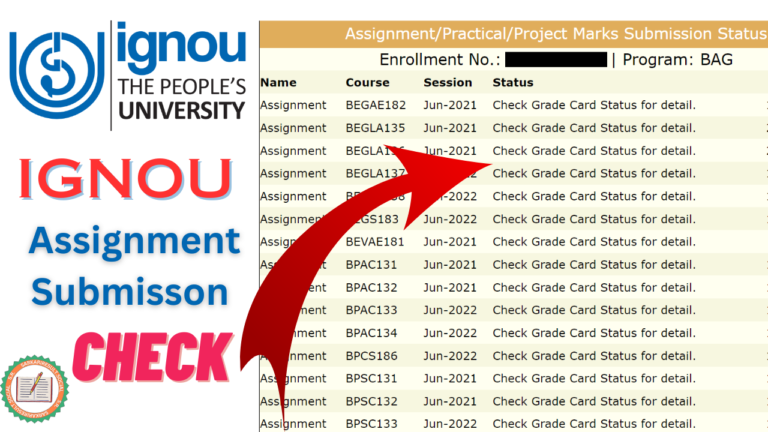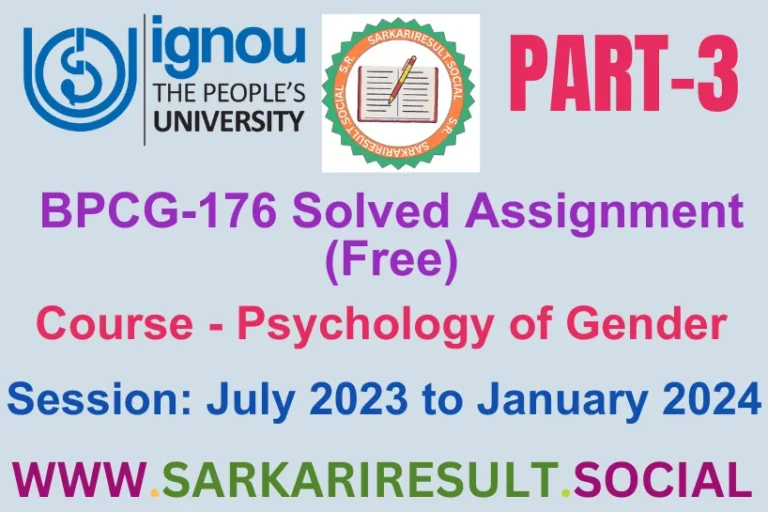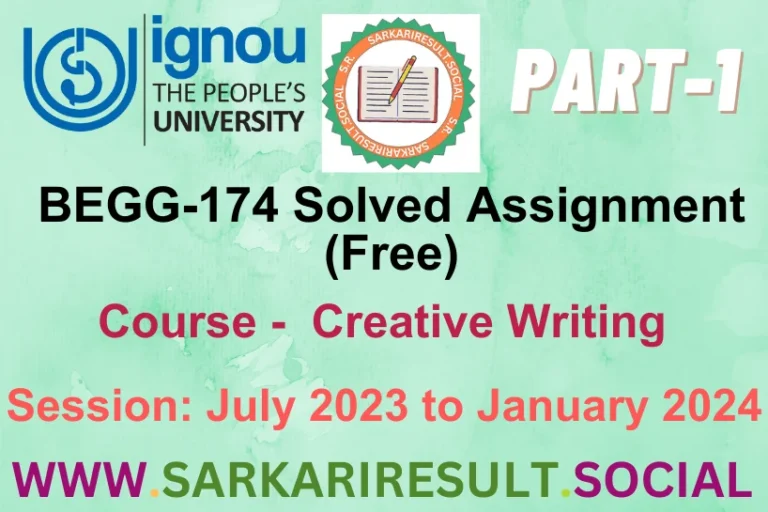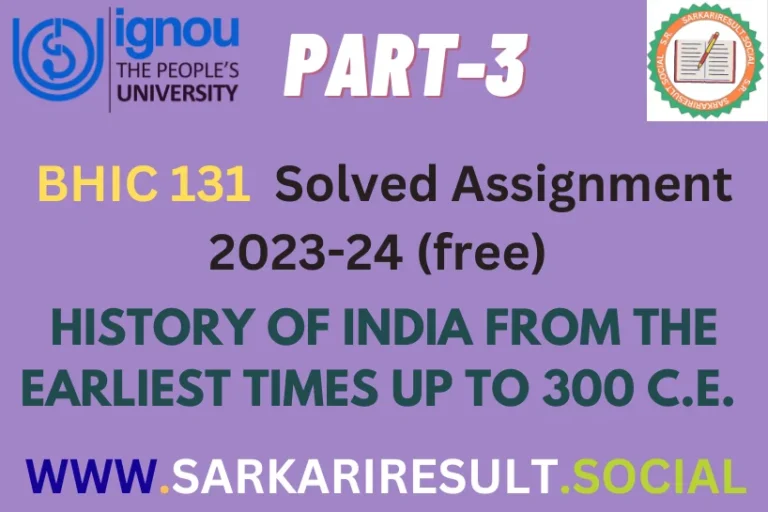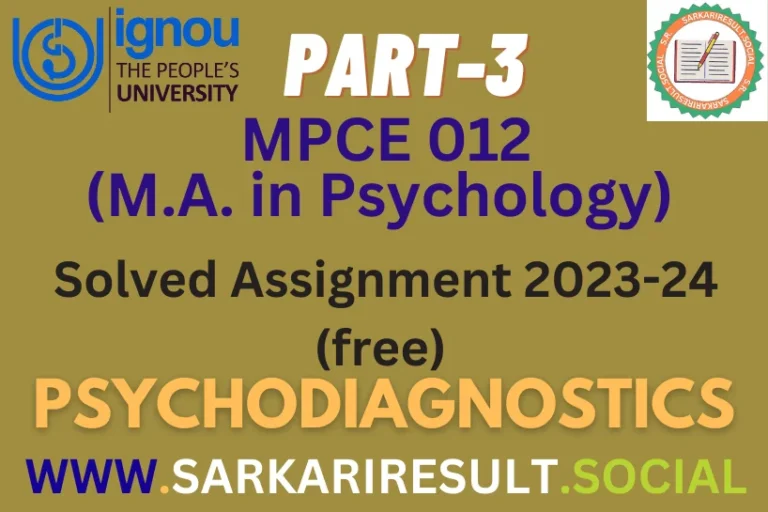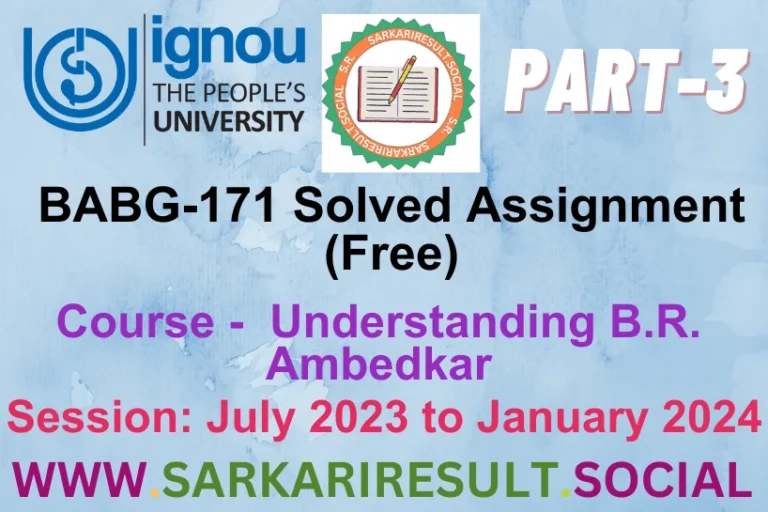BPCG 176 SOLVED IGNOU ASSIGNMENT FREE PART 1
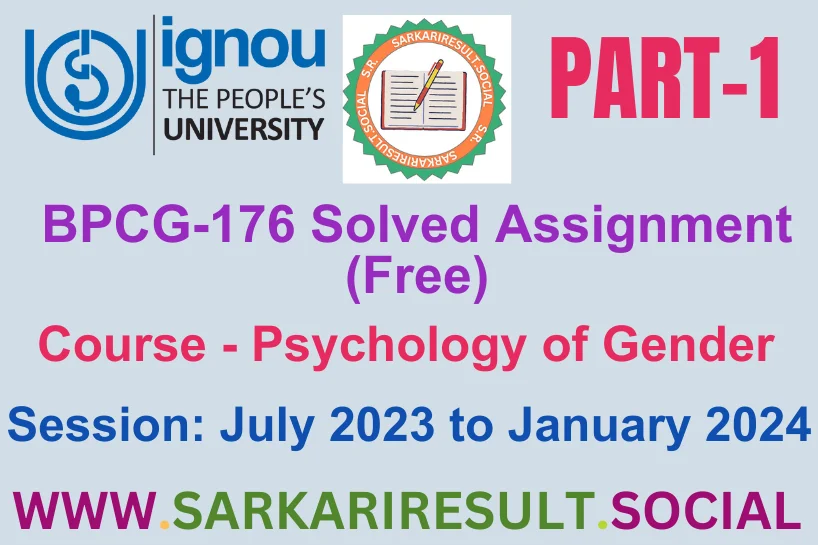
Welcome to the BPCG 176 SOLVED IGNOU ASSIGNMENT FREE PART 1 TMA. Our concise and insightful responses to the two questions in Assignment One provide a straightforward path for tackling these challenges. With each 500-word answer, addressing gender role attitudes and Alice Eagly’s social role theory, our solutions make mastering these concepts easy. Dive in and make your assignments a breeze with our comprehensive guidance. Our IGNOU Solved Assignments 2024 for this section serve as your creative guide.
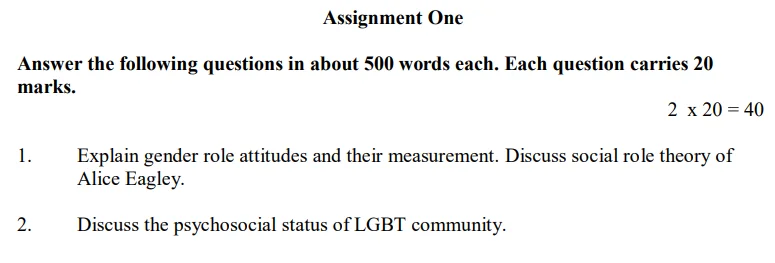
Answer the following questions in about 500 words each. Each question carries 20 marks.
Q.1 Explain gender role attitudes and their measurement. Discuss social role theory of Alice Eagley.
Ans. Gender role attitudes refer to beliefs and expectations about the appropriate roles and behaviors of men and women in society. These attitudes are shaped by cultural, social, and individual factors and influence how individuals perceive and behave in gendered roles. Measuring gender role attitudes involves assessing individuals’ beliefs regarding the division of labor, responsibilities, and behaviors associated with their gender.
Common Measurement Approaches:
1. Surveys and Questionnaires:
– Researchers use surveys and questionnaires to gather self-reported data on individuals’ attitudes toward gender roles. Questions may explore beliefs about family responsibilities, career expectations, and perceived gender norms.
2. Interviews:
– In-depth interviews allow researchers to delve into individuals’ perspectives on gender roles. This qualitative approach provides nuanced insights into personal experiences and cultural influences.
3. Observational Studies:
– Observing individuals’ behavior in various contexts can reveal implicit gender role attitudes. This method is particularly useful in understanding how societal norms influence everyday actions.
4. Implicit Association Tests (IAT):
– IATs measure implicit or unconscious biases related to gender roles. By assessing the speed of associations between gender and certain roles, these tests reveal underlying attitudes that individuals may not be aware of consciously.
5. Content Analysis:
– Analyzing media content, such as advertisements or television programs, helps assess societal gender role messages. Content analysis reveals cultural norms and expectations embedded in media portrayals.
Social Role Theory by Alice Eagly:
Alice Eagly’s Social Role Theory provides a framework for understanding how social structure and roles contribute to the development of gender roles and attitudes. Here are key aspects of the theory:
1. Division of Labor:
– Eagly argues that historical divisions of labor, where men were often associated with tasks requiring physical strength and women with caregiving, influenced the evolution of gender roles. Over time, these roles became embedded in societal expectations.
2. Social Structure:
– Social Role Theory posits that gender roles arise from the division of labor in society. As men historically engaged in tasks outside the home and women focused on domestic responsibilities, societal expectations and norms around gender roles emerged.
3. Prescriptive vs. Descriptive Gender Roles:
– Eagly distinguishes between descriptive gender roles (observed behaviors) and prescriptive gender roles (societal expectations). While the actual behaviors may change due to societal shifts, the expectations (prescriptions) often lag behind.
4. Adaptation to Roles:
– Eagly suggests that individuals adapt to the roles assigned by society. As men and women engage in certain tasks, they develop skills and preferences associated with those roles. This adaptation further reinforces gender role attitudes.
5. Evolutionary Perspective:
– Social Role Theory incorporates an evolutionary perspective, acknowledging that certain divisions of labor may have had adaptive advantages in the past. However, Eagly emphasizes that societal changes can and should lead to greater flexibility in gender roles.
In summary, Social Role Theory by Alice Eagly posits that gender roles arise from historical divisions of labor, shaping societal expectations and individual adaptations. Measurement of gender role attitudes involves a mix of quantitative surveys, qualitative interviews, observational studies, and implicit bias assessments to capture the complex and multifaceted nature of these attitudes.
Q.2 Discuss the psychosocial status of LGBT community.
Ans. The psychosocial status of the Lesbian, Gay, Bisexual, and Transgender (LGBT) community is multifaceted, shaped by historical, cultural, and societal factors. While significant progress has been made in recognizing and protecting the rights of the LGBT community in some regions, challenges persist, impacting their mental health, social relationships, and overall well-being.
1. Discrimination and Stigma:
Discrimination and stigma remain pervasive issues for the LGBT community. Prejudice, whether overt or subtle, can lead to social exclusion, limited career opportunities, and a constant fear of judgment. This societal stigma contributes to higher rates of mental health issues, including depression and anxiety.
2. Mental Health Disparities:
LGBT individuals often face mental health disparities compared to the general population. Factors such as minority stress, internalized homophobia, and discrimination contribute to higher rates of depression, suicidal ideation, and substance abuse within the community.
3. Family Rejection:
Family rejection can be a significant challenge for many LGBT individuals. Coming out may lead to strained relationships or, in some cases, complete estrangement from family members. Lack of familial support can impact emotional well-being and contribute to feelings of isolation.
4. Bullying and Harassment:
LGBT individuals, especially youth, frequently experience bullying and harassment. School environments, workplaces, and even public spaces may pose threats to their physical and psychological safety. Persistent exposure to such hostile conditions can lead to long-term emotional trauma.
5. Legal Inequalities:
In regions without comprehensive legal protections, LGBT individuals may face discrimination in areas such as employment, housing, and healthcare. Legal inequalities contribute to a sense of vulnerability and can impact the ability of the community to access essential services.
6. Healthcare Disparities:
LGBT individuals may encounter healthcare disparities, including inadequate access to culturally competent healthcare providers. Fear of discrimination from healthcare professionals may lead to delays in seeking medical assistance, negatively affecting overall health outcomes.
7. Intersectionality:
The experiences of LGBT individuals are further influenced by intersecting identities, such as race, ethnicity, and socioeconomic status. For instance, LGBT people of color may face compounded discrimination and marginalization, exacerbating the psychosocial challenges they encounter.
8. Supportive Networks:
Despite challenges, many individuals within the LGBT community find support and resilience through advocacy organizations, community centers, and online networks. These spaces offer a sense of belonging, understanding, and empowerment.
9. Visibility and Representation:
Increased visibility and positive representation of LGBT individuals in media and society contribute to changing perceptions and reducing stigma. Representation plays a crucial role in fostering understanding and acceptance.
10. Advancements in Legal Protections:
Legal advancements, such as the recognition of same-sex marriage and anti-discrimination laws, mark positive steps toward equal rights for the LGBT community. These legal changes contribute to improved psychosocial well-being by promoting a sense of validation and acceptance.
11. Mental Health Support:
There is a growing awareness of the mental health needs within the LGBT community, leading to increased availability of specialized mental health services. Culturally competent therapists and support groups contribute to addressing mental health disparities.
In conclusion, the psychosocial status of the LGBT community reflects a complex interplay of societal attitudes, legal frameworks, and individual resilience. While progress has been made, continued efforts are essential to create inclusive environments that recognize and affirm the diverse experiences within the LGBT community, fostering mental health and overall well-being.
Also See This: BPCG 176 SOLVED IGNOU ASSIGNMENT FREE PART 2

